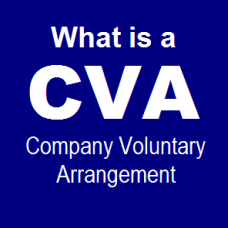In the past couple of weeks we have received a number of phone calls asking us what a ‘CVA’ is. A number of misconceptions appear to be held, so we have outlined below our understanding and opinion on how CVA’s work:
Company Voluntary Arrangement’s (CVA’s) were introduced under the Insolvency Act 1986, and are aimed at saving or turning around a business either in whole or in part. Under a CVA the company continues to trade, paying off agreed debts over time, whilst working to turn the business around.
A CVA is a legal arrangement processed through the courts. CVA’s can only be used if a company is insolvent but is still viable. (Insolvency is the inability to pay the company debts as they fall due. When a company is unable to pay off its debts, it is referred to as insolvent.)
A CVA must be overseen by a licensed Insolvency Practitioner. In a CVA, creditors often agree a plan to write off a proportion of a business’s debt. The CVA usually involves creditors receiving reduced payments over a fixed term while the company continues to trade. The repayments are usually calculated after working out what the business can actually afford to pay out. During the CVA period the creditors agree that they will not individually take action to recover their debts to the business, giving the business effective protection from creditors. The CVA Structure ensures that all creditors are treated equally and the return to creditors is maximised.
The directors remain in control of the company during a CVA, as long as the company does not breach the terms. If however the CVA fails, the company is usually put into liquidation by the Licensed Insolvency Practitioner.
When a company applies to the court for a CVA, the repayment plan and future trading proposal must be seen as reasonable and achievable. A creditors meeting must be held for any CVA. Creditors need to be given 14 days written notice of the creditors meeting. Typical lead time for the creditors meeting is 4-5 weeks from the Insolvency Practitioner receiving instructions to apply for a CVA.
The CVA proposal must also be approved by 75% of the business’s creditors voting on the day. (This is 75% of the debt value, and not 75% of the creditor companies.) Once approved, the CVA becomes a legally binding agreement that binds all creditors to the agreement whether they voted in support or against the CVA.
The purpose of a CVA is to rescue the business whilst also being in the best interests of their creditors, as if the company were to simply liquidate the business the creditors may receive little or no repayment from what they are owed.
Whilst a CVA relieves the company cashflow pressure short term, the debt repayment agreed with the creditors will normally need to be repaid within 3 to 5 years under the CVA. Once the agreed debts have been repaid the company can exit the CVA.
Prior to formally applying for a CVA it is not unusual for the company to informally approach the main creditors to see if they would accept a proposed repayment offer under a CVA. It would seem pointless to apply for a CVA unless the company had some confidence the main creditors would accept the proposed repayment plan.
Should a CVA be put in place, the company’s new position is likely to become common knowledge, and this normally results in some suppliers then providing goods on a proforma basis. It is certainly not a position either the company or its creditors wish to be in, but some may consider it as a more honourable option than the one taken by some companies in simply walking away from all debt and starting a ‘phoenix’ company.
Within the industry a CVA generates views across the spectrum. Some see a CVA as an ‘easy’ get out for insolvent companies and unfair on companies that manage to trade paying all of their debts in full, others see it as a sensible option which demonstrates that the company are trying to maximise creditors interests, rather than simply taking the company into liquidation. Whatever someone’s view, a company is made up of real people and jobs would be lost if a company ceases to trade. Perhaps new jobs would be created elsewhere from the organic re-distribution of the future sales, but who knows.
There is no doubt that the promotional merchandise market today is tough, and there are no current signs of much recovery, indeed Sourcing City know of 49 ‘professional distributor’ companies who have ceased trading since January, and have dozens of others who we are ‘unable to trace’ and are still researching. Many of these are ‘small distributors’, yet at the same time large distributors are not immune. Some companies that have ceased trading have restarted as ‘phoenix’ companies, which appears universally unpopular with many in the trade. These ‘ceased trading’ figures do not include many ‘printers etc.’ who dabbled in the market, and then failed.
The problem when a company ceases to trade is of course, that the first anyone knows of it, is when it happens!
Popular or not, CVA’s provide a way for companies to continue to trade, whilst creating the opportunity to turn their business around, maintain employment, and repay supplier debt in part from future sales and rebuilt profits. Whilst they do give suppliers the opportunity to recover a proportion of their monies owed, the company’s competitors may also feel that it gives them an unfair commercial advantage by losing a proportion of their debt. What would be agreed, is that no-one is left totally happy.
A worse situation that we have all witnessed, is when a company closes one day, and within hours a new company is trading free of debt with the same directors, office, website and telephone numbers etc. Other companies in the trade who may have been interested to buy the company in full or part, never know or get the opportunity to bid for the assets, leaving the creditors more out of pocket than necessary. How this is allowed to happen legally we will never understand.
More information on CVA’s here.
Published on: January 1st, 1970





